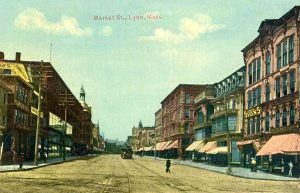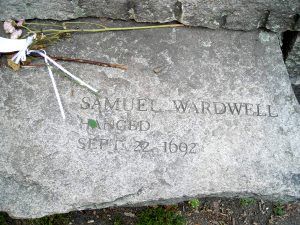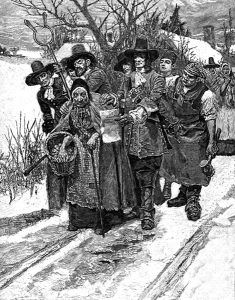Witches of Salem: Index A B C D E F-G H I-J K-N O-P Q-S T U-Z
Rachel Varney Cook Langton Vinson (1631-1707) – The daughter of William and Bridget Varney, Rachel was born in about 1631. Sometime before 1649, she married a man named Thomas Cook, who was known as a troublesome character. Living in Ipswich, Thomas Cook was in court for speaking out against the local minister in 1649. His father-in-law bailed him out of jail. A short time later, the couple lived in Lynn, where Thomas worked at the ironworks. In 1650, they would have a son they named John. That same year, he was arrested for drunkenness on at least two occasions. That same year, he died.
Rachel Varney Cook then married a second and more unpleasant man named Joseph Langton, who had also been previously arrested for excessive drinking. In 1652, Langton was in court for the “evil usage of a little child of his wife.” Apparently, Rachel’s son, John Cook, was found lying on the straw with but a piece of sailcloth to cover him in his cradle, having been beaten to keep him quiet. The court ordered the baby to be placed in the care of his Varney grandparents. Afterward, he either died or deserted his wife because there were no more records of him. Though their union was brief, Rachel would have two daughters with him – Rachel and Mary Langton.
Rachel would later marry her third husband, William Vinson of Gloucester, on June 10, 1661. The couple would have two children — Thomas and Abigail. William Vinson died on September 17, 1690, in Gloucester. Two years later, in September 1692, the Widow Vinson would be arrested for witchcraft. She was jailed in Ipswich but was released on bond on September 24, 1692. By this time, the witch hysteria was coming to an end, and she was never tried. Rachel died in Gloucester on February 15, 1707.
Samuel Wardwell, Sr. (1643-1692) – Of Andover, Massachusetts, Wardwell was convicted of witchcraft and hanged with several others on September 22, 1692. He was born to Thomas Wardwell and Elizabeth Hooper Wardwell in Boston on May 16, 1643. A Quaker family, Samuel’s oldest brother, Eliakim, moved to New Jersey in 1664 to become a leader among a large group of Quakers who had recently moved there. His other older brother, Benjamin, moved to Salem Towne about the same time in search of a seaman’s job. Young Samuel, 21 years old then, was just finishing a carpentry apprenticeship in Boston and soon followed his brother to Salem. At some point, Samuel met a woman whose name has been lost in history, and the two married. They had a son they named Thomas in January 1670. Unfortunately, his wife died just a year later. Samuel then moved with his small son to nearby Andover.
Working as a carpenter by trade, Samuel married a wealthy widow named Sarah Hooper Hawkes on January 9, 1673. He would take in her daughter, Sarah Hawkes, Jr., and the couple would have seven children of their own. Up until 1692, Samuel was regarded by the locals as an eccentric but harmless fellow who liked to entertain his friends by telling fortunes and playing with magic. Though the practice of fortune-telling was not uncommon among New Englanders in the seventeenth century, it was a forbidden practice by Puritans. Wardwell’s well-known practice of magic, albeit for sport, made him a prime target for witchcraft accusations in 1692. Further leading to his accusations may have been due to his neighbors’ jealousy of his sudden wealth. By 1692, the Wardwells were living comfortably on their farm at the south end of Andover. Because of the recent growth of the town and many buildings being erected, Samuel had faired very well as a carpenter. He was also a Quaker, which many Puritans of the time distrusted.
He was first accused by 16-year-old Martha Sprague of Boxford, who would not only say that he had afflicted her by pinching, striking, and sticking pins into her body but would also say that he had afflicted Rose Foster and her mother, Hannah. Wardwell was arrested on August 15, 1692, and imprisoned in Salem Towne. Before long, his wife, Sarah, and daughters, Sarah Hawkes, Jr. and Mercy Wardwell, were also accused of witchcraft. Witnesses against him were not only the familiar group of Salem Village girls but also three respectable citizens of Andover: Joseph Ballard and Thomas Chandler, neighbors of his who also served as selectmen, and Ephraim Foster, who for years had been clerk of the proprietors. When he was examined on September 1, 1692, he confessed before magistrate John Higginson, saying that he had indeed dabbled in the supernatural by “telling of fortunes.” Under intense questioning, he would also confess to making a pact with the Devil. Later, he would recant his confession, declaring that his tormentors had persuaded him, under emotional stress, to confess, that he regretted that he had even once “belied” himself, and announced that even though it might cost him his life, he would stick to the truth. Samuel Wardwell was hanged on September 22, 1692, along with seven women. In later examinations, Samuel Wardwell would be used as an example of what might happen to people if they recanted.
Sarah Hooper Hawkes Wardwell (1650- before 1712) – The daughter of William Hooper, Sarah was born in Reading, Massachusetts, in 1650. She would grow up to marry Adam Hawkes in Lynn, Massachusetts, in June 1670. Adam Hawkes was much older than she was, and she did not wish to marry him. However, she did, and the couple had a daughter they named Sarah. Shortly after she gave birth to her child, her elderly husband died, leaving his wife one-third of his estate, making her a wealthy young widow. She soon caught the attention of many eligible men but rejected them all and chose to marry the penniless Samuel Wardwell on January 9, 1673. Since Samuel already had a reputation for telling fortunes and other devilish actions, there was talk that he had bewitched Sarah into marrying him. In addition to taking in Sarah’s young daughter by the same name, the couple would have seven children of their own. After her husband, Samuel, was arrested for witchcraft in August 1692, Sarah, along with her daughter Mercy Wardwell and Sarah Hawkes, Jr., would also be arrested. When she was examined on September 1st, she would confess to being baptized by the Devil and had once attended a witch meeting in Salem Village. She claimed that she had seen several other witches at that meeting, including Ann Hooker Foster and some men in handsome apparel. She also confessed to afflicting Martha Sprague. She was sent to prison, carrying her baby daughter, Rebecca, with her. She and her daughters were in jail when her husband was hanged on September 22, 1692. While she was imprisoned, Sheriff George Corwin confiscated a great deal of their property, and Sarah’s other children were sent to neighboring families. In addition to the property she owned with Samuel, the property that had been left to her in Lynn by her first husband was also confiscated. Sarah remained imprisoned until she was finally brought to trial on January 2, 1693. Like her husband, she was found guilty. However, she would later be pardoned by Governor William Phips and released. However, having all their property confiscated, the family was destitute. In 1712, his mother, Samuel Wardwell, Jr., meanwhile having died, requested and received compensation for the financial loss that his family had suffered.
Mercy Wardwell – (1673-1754) – Born to Samuel Wardwell and Sarah Hooper Hawkes Wardwell in 1673, 19-year-old Mercy was charged with witchcraft and arrested shortly after her father was imprisoned for the same crime. Her mother, Samuel Wardwell, and half-sister, Sarah Hawkes, Jr., would also be charged. On September 15, 1692, Mercy confessed to having been baptized by the Devil and to having afflicted Martha Sprague, Rose Foster, and Timothy Swan. She was imprisoned, never tried, and sometime later was released.
Mary Warren (1671?-??) – Born twenty-one years before the Salem Witch Trials began, Mary Warren was the oldest of the “afflicted girls” and became one of the most rigorous accusers. She also became a defender and confessor, a unique role among the accusing girls of Salem Village. See more HERE.
Sarah Averill Wildes (1627-1692) – Having a magistrate for a husband did not prevent Sarah from being tried, convicted, and executed for witchcraft in Salem, Massachusetts. Sarah was born to William Averill and Abigail Hynton Averill in Chipping, Norton, England. Somewhere along the line, the family immigrated to America. At the age of 36, Sarah would marry John Wildes on November 23, 1663, in Topsfield, Massachusetts. The couple would have just one child. John had previously been married to Priscilla Gould Wildes, and they had nine children. Priscilla had died just months before, in April 1663.
John Wildes’ quick marriage following the death of his first wife, as well as the somewhat “bad reputation” of Sarah Averill, immediately caused problems in the family. Years before, in November 1649, Sarah had been in court, having been accused of “too great intimacy with Thomas Wardell” in nearby Ipswich. Later, in the same year she married John Wildes, she was presented with the lesser offense of “wearing a silk scarf” in May 1663, also in Ipswich. Early on, problems appear between the couple and his first wife’s brother, Lieutenant John Gould, and her sister, Mary Gould Reddington. This situation first became evident at the will of John Wildes, Jr., son of John Wildes, and his first wife, Priscilla Gould Wildes. In John Jr., he makes reference to his inheritance from his grandfather Zaccheus Gould, hoping that his father might not be troubled by any claims made by his uncle, Lieutenant John Gould. Years later, in 1686, John Wildes, Sr., testified against his ex-brother-in-law, Lieutenant John Gould, when he was charged with treason. In 1685, when King James II appointed Edmund Andros as the Royal Governor of Massachusetts, serious unrest occurred in the colony. After speaking out about his displeasure, John Gould was arrested for treason. He was found guilty of “uttering malicious treasonable and seditious speeches” in August 1686. After paying a fine, he was released, but he would never forgive his former brother-in-law, John Wildes. Shortly afterward, Mary Goulds Reddington began to spread witchcraft stories about Sarah Averill Wildes. John Wildes then threatened to sue Mary’s husband, John Reddington, for slander, but, Mary denied her previous statements. But, for Sarah Averill, the damage had already been done.
Making matters worse for Sarah was the fact that the Goulds were related to the powerful Putnam family of Salem Village. On April 21, 1692, a warrant was issued for Sarah’s arrest based on a complaint made the same day by Thomas Putnam, Jr. and John Buxton of Salem Village. She and others were accused of afflicting Ann Putnam, Jr., Mercy Lewis, and Mary Walcott. She was arrested the next day by Salem Village Marshal George Herrick, who took her to Salem Village, where Justices Hathorne and Corwin examined her at the Salem Village meetinghouse. In this examination and later ones, she would not only be accused by the afflicted girls but also by Deliverance Hobbs, who had also been accused and just happened to have been arrested by John and Sarah’s son, Ephraim Wildes, who held the position of Topsfield constable. Deliverance would say that Sarah had brought her the Devil’s book to sign, to which Sarah replied, “I am not guilty, sir… I never saw the book in my life or these persons before.”
Also arrested at the same time as Sarah Wildes were John Wildes’ daughter and son-in-law, Edward and Sarah Wildes Bishop of Salem Village, and his daughter Phoebe Wildes Day of Ipswich. On May 13, 1692, 65-year-old Sarah was sent to the Boston Jail in fetters and handcuffs to await further trial. During her imprisonment, her husband, John, and their son, Ephraim Wildes, traveled back and forth to see that Sarah was fed and clothed and to give her such comfort as they could. There were a number of people during her trial or in depositions that provided testimony against her, including Humphrey Clark, Thomas Dorman, John Andrew John Gould, Zacheus Perkins, Elizabeth Symonds, Nathaniel Ingersoll, and the Reverend John Hale. Sarah Averill Wildes was condemned for the practice of witchcraft. She was executed by hanging in Salem, Massachusetts, on July 19, 1692.
Ruth Wilford (1672-1708) – Ruth was born on November 15, 1672, to Gilbert and Mary Dow Wilford, probably in Haverhill, Massachusetts. On August 18, 1692, an arrest warrant was issued for her upon a complaint sworn out by Timothy Swan of Andover. The complaint alleged that Ruth Wilford had afflicted Mary Walcott and Ann Putnam, Jr. She was arrested two days later and brought before the Justices of the Peace at Salem Village. No further information is known regarding the proceedings. She would later marry Thomas Ayer, also of Haverhill, on June 12, 1694. The couple would eventually have four children. On August 29, 1708, she and her daughter, also named Ruth, were killed by an Indian attack at Haverhill, Massachusetts.
John Willard (1657–1692) – A deputy constable at the time the witch hysteria erupted in 1692; John Willard would become one of the first to speak out against the madness, saying that the only “witches” were those who were afflicted. For this statement, he would pay with his life, being hanged as a witch himself on August 19, 1692. See the full story HERE.
Sarah Lord Wilson (1648-1727) – Sarah was one of the many women in Andover, Massachusetts, who were arrested after the infamous “touch test” examination conducted by the Reverend Thomas Barnard on September 7, 1692. Sarah Lord was born about 1648 in Ipswich, Massachusetts, to Robert and Mary Waite Lord. Her father was a prominent resident of Ipswich who served as Town Clerk from 1645 until his death in 1683. On April 24, 1678, Sarah Lord married the widower Joseph Wilson of Andover, and the couple eventually had four children. In 1692, when the infamous witch hysteria began, Joseph and Sarah were living with their children in the southern part of Andover and were active members of the Andover church.
On September 7, 1692, the Reverend Thomas Barnard called certain members of Andover’s elite to the meetinghouse. At the meeting, several of the Salem Village “afflicted girls” were present. After a short prayer, Reverend Barnard launched into a sermon describing the evils of witchcraft. He then began to conduct the “Touch Test,” one of the most diabolical schemes of the witch trials. After these tests were conducted, Justice of the Peace Dudley Bradstreet dutifully wrote out the arrest warrants for 18 men and women who had been accused in the touch test. These warrants included both Sarah Lord Wilson and her 14-year-old daughter, Sarah Jr. After all these people were imprisoned and awaiting trial, the Reverend Francis Dane formed a resistance movement against the madness. On October 15th, a number of Andover children, including Sarah Wilson, Jr., were released on bail. The Reverend Dane would continue to work to release the other jailed members, and on January 13, 1693, Sarah Lord Wilson was also released on bond. On May 10, 1693, both mother and daughter appeared at the Superior Court of Judicature at Ipswich and were cleared. The family remained in Andover after the witchcraft scare subsided. Joseph Wilson died on April 2, 1718. Sarah died in Andover on May 21, 1727.
Sarah Wilson, Jr. (1678-17??) – Of Andover, Sarah was the 14-year-old daughter of Joseph and Sarah Lord Wilson. She and her mother were arrested for witchcraft on September 7, 1692, after the Reverend Thomas Barnard conducted his infamous “touch test.” After spending six weeks in prison, she was released on bail on October 15th. Later, in January 1693, her mother was also released. On May 10, 1693, both mother and daughter appeared at the Superior Court of Judicature at Ipswich and were cleared. She married Jacob Preston on June 17, 1702, and the couple moved to Ashford, Connecticut.
Mary Buckley Witheridge – The daughter of William and Sarah Smith Buckley, both she and her mother were arrested for witchcraft on May 14, 1692, and imprisoned. At the time of her arrest, Mary was already a widow, having earlier married Sylvester Witheridge of Marblehead. She and her mother were accused of having afflicted Mary Walcott and Ann Putnam, Jr. and were examined on May 18th. Elizabeth Hubbard and Mercy Lewis would also testify against her. Though her father, William Buckley, convinced two pastors to speak in favor of her and her mother, it wouldn’t be enough. Both were sent to prison. After spending some eight months in prison, both Sarah Smith Buckley and her daughter were found not guilty in January 1693 and were discharged after paying her fees. Mary would later marry Benjamin Proctor, who had also been accused of witchcraft, on December 18, 1694.
Edward Wooland – Though Edward Wooland was known to have spent some time in jail under the accusation of witchcraft, nothing more is known of him.
© Kathy Alexander/Legends of America, updated January 2024.
Also See:
The Salem Witchcraft Hysteria (Main article)
Procedures, Courts & Aftermath



